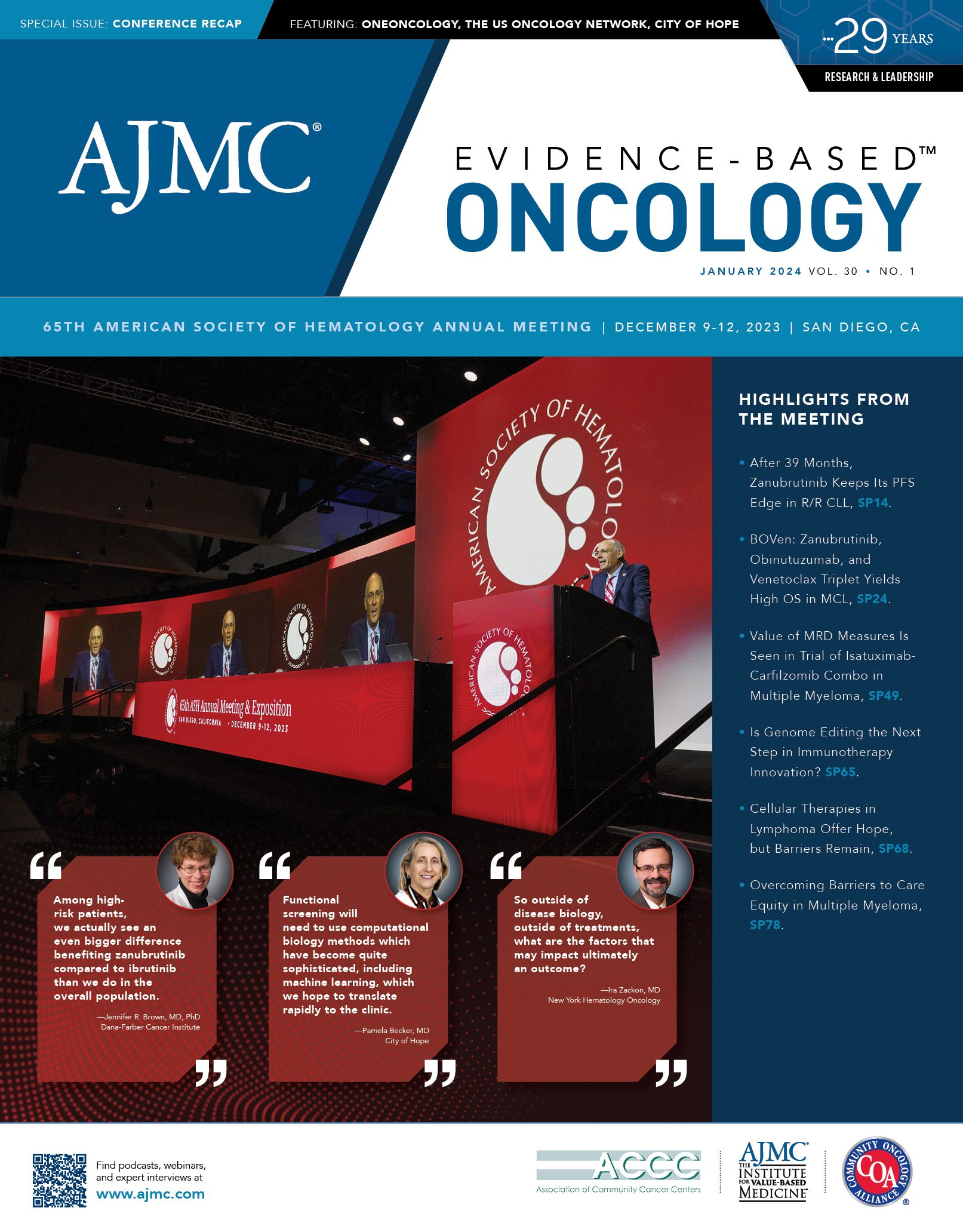- Center on Health Equity & Access
- Clinical
- Health Care Cost
- Health Care Delivery
- Insurance
- Policy
- Technology
- Value-Based Care
ASH 2023: Coverage in Multiple Myeloma
Selected coverage of multiple myeloma from the 65th American Society of Hematology Annual Meeting and Exposition, December 9-12, 2023, San Diego, California.
Adding Isatuximab to Carfilzomib-Based Combo for Those Newly Diagnosed With Multiple Myeloma Boosts MRD Negativity Rates
Patients who were newly diagnosed with multiple myeloma and eligible for transplant achieved greater rates of minimal residual disease (MRD) negativity when isatuximab (Sarclisa) was added to a regimen of carfilzomib (Kyprolis), lenalidomide (Revlimid), and dexamethasone (KRd), according to trial results presented December 10, 2023.
The findings from the phase 3 IsKia trial (NCT04483739), which compared MRD rates in patients treated with isatuximab and KRd and those treated with KRd alone, were unveiled during the plenary session of the 65th American Society of Hematology Annual Meeting and Exposition, taking place in San Diego, California.1
Francesca Gay, MD, PhD | Image: University of Torino

Francesca Gay, MD, PhD, a hematologist and associate professor at the University of Torino, Italy, explained that current standard of care for patients with multiple myeloma who are eligible for a bone marrow transplant consists of induction with proteasome inhibitors, immunomodulatory agents, dexamethasone, and an anti-CD38 monoclonal antibody, followed by high-dose melphalan and autologous stem-cell transplant (ASCT). IsKia was designed to use MRD to assess the efficacy and safety of isatuximab plus KRd as a pretransplant induction and a posttransplant consolidation regimen, compared with KRd.
Use of isatuximab with KRd in this patient group is investigational, Sanofi officials, the makers of isatuximab, said in a statement.2
MRD as a Surrogate End Point
MRD negativity is defined as the absence of myeloma cells in the bone marrow following treatment, as measured by a validated diagnostic test that must have a sensitivity of at least 1 in 100,000 cells. The IsKia trial measured MRD negativity with a sensitivity of 10-5, which means no cancer cells were detected within 100,000 bone marrow cells, and also 10-6, which means no cancer cells were detected within 1,000,000 bone marrow cells.
FDA does not currently accept MRD negativity as a surrogate end point to compare drug combinations in multiple myeloma, but as plenary commenter Peter Voorhees, MD, of Atrium Health Levine Cancer Institute explained, advances in the field and the use of 4 classes of agents to treat relapsed disease call for one. “Increasingly, it’s become difficult to discern overall survival differences,” he said.
Voorhees was the lead author for recent final results of the GRIFFIN trial involving the monoclonal antibody daratumumab, lenalidomide, bortezomib, and dexamethasone in multiple myeloma.3 He commented, “How do you improve upon on a 4-year progression-free survival of 87%?” Then, he posited that a hypothetical phase 3 study would require enrollment of more than 1700 patients, take more than 4.5 years to accrue patients, and last more than 9 years to determine PFS.
“Clearly, we need a surrogate end point for longitudinal outcomes,” he said.
Study Design and Methods
To be eligible for IsKia, patients with newly diagnosed multiple myeloma had to be younger than 70 years. Gay explained that patients in the trial went through 4 phases of treatment: induction, ASCT, consolidation, and light consolidation; MRD was measured at the end of each phase. Patients in both arms received the same dosing schedules of KRd in each cycle, but patients in the isatuximab arm were treated with the monoclonal antibody intravenously on days 1, 8, 15, and 22 of the first cycle; followed by days 1 and 15 on cycles 2 to 4.
The primary end point was the rate of MRD negativity as measured by next-generation sequencing (10-5) after consolidation in the intent-to-treat (ITT) population. MRD was tested in all patients who achieved at least a very good partial response. Key secondary end points are rates of MRD negative (10-5) after induction and PFS.
Results
The trial enrolled 302 patients who were randomly assigned 1:1 and well balanced between the 2 arms. Of note, median age was 61 years for the isatuximab-KRd arm and 60 years for the KRd-only arm; 18% and 19% of patients had high-risk clinical features, respectively; these included 17p deletion, t(4;14), t(4;16), and gain/amp(1q).
Gay explained during the session that MRD negativity levels increased after each phase of treatment. Results of the ITT analysis showed the following:
- For the primary end point, rates of MRD negativity at the 10-5, cutoff following consolidation were 77% for the isatuximab-KRd arm and 67% for the KRd-only arm (OR, 1.67; P = .049). Rates of MRD negativity at the 10-6, cutoff were 67% vs 48%, respectively (OR, 2.29; P < .001).
- The MRD negativity advantage at both cutoff levels was retained across subgroups, with similar benefits seen in patients with standard-risk and high-risk patients.
- The MRD negativity rate after induction, the first secondary end point, was also significantly greater in the isatuximab-KRd group than it was in KRd patients. At 10-5,, the comparison was 45% vs 26%, for OR, 2.34; P < .001. At 10-6, it was 27% vs 14%, OR, 2.36; P = .004).
- MRD rates after transplant were significantly better for the isatuximab group: at 10-5,, they were 64% vs 49%, OR, 1.93; P = .006. At 10-6,, they were 52% vs 27%, OR, 3.01; P < .001. Investigators reported advantages were consisted across subgroups.
- At the current follow-up median of 20 months, there is not yet any difference in PFS. Gay said the data are not mature and will be reported at a later date.
- Among adverse events (AEs), 55% of patients in the isatuximab arm reported 1 hematological event, compared with 43% of patients in the KRd-only arm. The major grade 3 to 4 AEs in both arms were neutropenia (37% vs 22%, respectively), and thrombocytopenia (15% vs 17%).
- Nonhematological AEs were seen in 41% of the isatuximab patients vs 37% of the KRd-only patients; infections and gastrointestinal events were slightly higher in the isatuximab group but cardiac and vascular events were higher in the KRd-only group.
- Four deaths were reported in the isatuximab group: 2 from COVID-19, 1 from pneumonia, and 1 pulmonary embolism; 1 death from septic shock occurred in the KRd-only group.
In her concluding remarks, Gay noted that the combination with isatuximab produced particularly good MRD negativity rates among patients with high-risk clinical features, relative to the KRd-only group.
Overall, she said, the increase in MRD negativity “was evident already after induction, and the rate of response progressively increased with treatment. The advantage for the isatuximab [group] we’re seeing in our subgroups of patients includes the high-risk group,” she said. “Treatment was tolerable with a toxicity profile that was similar to that in previous records.”
Use of MRD, she said, “may be more informative” than other potential surrogate end points in multiple myeloma.
Peter C. Adamson, MD, global development head of oncology for Sanofi, said in a statement: “The statistically significant rates of MRD negativity observed with [isatuximab] combination therapy further support our belief in [isatuximab] as a potential best-in-class therapy. Effective front-line treatment is critical for newly diagnosed patients, because achieving undetectable levels of disease early in the treatment journey may lead to better long-term outcomes.”2
References
1. Gay F, Roeoffzen W, Dimopoulous MA, et al. Results of the phase III randomized IsKia trial: isatuximab-carfilzomib-lenalidomide-dexamethasone vs carfilzomib-lenalidomide-dexamethasone. Presented at: 65th American Society of Hematology Annual Meeting and Exposition; December 9-12, 2023; San Diego, CA. Paper No. 0004. doi:10.1182/blood-2023-177546
2. Sarclisa (isatuximab-irfc) plus KRd significantly improved the rate of minimal residual disease negativity in transplant eligible patients with newly diagnosed multiple myeloma versus KRd alone. News release. Sanofi. December 11, 2023. Accessed December 13, 2023. https://bit.ly/3Nvr1tY
3. Voorhees PM, Sborov DW, Laubach J, et al. Addition of daratumumab to lenalidomide, bortezomib, and dexamethasone for transplantation-eligible patients with newly diagnosed multiple myeloma (GRIFFIN): final analysis of an open-label, randomised, phase 2 trial. Lancet Haematol. 2023;10(10):e825-e837. doi:10.1016/S2352-3026(23)00217-X.
Applying CAR T Cells and Bispecific Antibodies in Multiple Myeloma: Strategies, Benefits, and Challenges
Immune-based therapies such as chimeric antigen receptor (CAR) T cells and bispecific antibodies (BsAbs) have changed the treatment paradigm and can lead to deep, durable responses in heavily pretreated patients with multiple myeloma. However, these cutting-edge immunotherapies come with challenges, including a range of toxicities and acquired resistance to treatment.
Nizar J. Bahlis, MD

Surbhi Sadana, MD

During a session at the 2023 American Society of Hematology (ASH) Annual Meeting and Exposition in December in San Diego, California, the nuances of utilizing CAR T-cell therapies and BsAbs in the treatment of multiple myeloma were discussed by presenters Nizar J. Bahlis, MD, associate professor of medicine at Cumming School of Medicine, Department of Oncology, at the University of Calgary in Alberta, Canada; Sham Mailankody, MBBS, clinical director of cellular therapy service at Memorial Sloan Kettering Cancer Center in New York, New York; and Surbhi Sidana, MD, assistant professor of medicine at Stanford University in California.
There are now BsAbs targeting a range of antigens found on the surface of myeloma cells, Bahlis explained. These targets include B-cell maturation antigen (BCMA), GPRC5D, and FcRL5. BsAbs targeting BCMA, GPRC5D, and FcRL5 have also shown impressive efficacy, with the GPRC5D-targeting BsAbs showing even higher response rates than BCMA-targeted therapies, but also unique toxicities due to GPRC5D being expressed on keratinized tissue such as nails in addition to myeloma cells.
Bahlis turned the focus to mechanisms of resistance to BsAbs, which can be broadly classified into either tumor-intrinsic mechanisms or immune-intrinsic mechanisms. Currently, the understanding is that nonresponse to BsAbs, or primary resistance, is typically due to high disease burden or extramedullary disease (EMD).
High disease burden, including increased bone marrow plasma cells and more advanced International Staging System (ISS) stage disease, has been associated with primary resistance in research on BCMA-directed therapies.1 In studies of GPRC5D-directed agents, advanced ISS stage has shown a lesser impact on response, whereas EMD has been linked with nonresponse.2 Bahlis also noted that high baseline serum soluble BCMA has been associated with lower response rates and high-risk disease characteristics.3
“I believe that soluble BCMA can be a biomarker for response to bispecific antibodies, especially when we have very high soluble BCMA levels, above 400 to 500 ng/mL,” Bahlis said, noting that additional analyses also support this notion. Adjusting the dose of anti-BCMA BsAbs can help overcome high soluble BCMA, as can using drugs to reduce soluble BCMA levels, such as γ-secretase inhibitors, which are currently being investigated in combination with anti-BCMA antibodies, Bahlis said. Characteristics of T-cell exhaustion are also potential indicators of lower response rates and poorer outcomes.
Disease that responds to BsAbs before progression is likely due to tumor-intrinsic characteristics, such as mutations developing after treatment initiation leading to antigenic loss. However, Bahlis noted that mutations are not always detrimental and can sometimes impact one antibody while retaining the sensitivity of another.
“This has a huge therapeutic application for us,” Bahlis explained. “That means we can treat the patient with one BCMA bispecific antibody and if they progress on it, we can potentially go back and use another bispecific antibody not affected by this mutation. But we need some more data on this before we start applying that clinically.”
Remaining questions include how to optimally sequence BsAbs—both with other BsAbs and with CAR T-cell therapies—and how long to treat patients with BsAbs. So far, Bahlis said, it seems patients can go from one BsAb to another and have durable responses, particularly if there are no signs of T-cell exhaustion. When patients transition from BsAbs to CAR T, T-cell exhaustion or skewed T-cell repertoires may impact CAR T efficacy. Moving from CAR T-cell therapy to BsAbs could potentially elicit good responses, Bahlis said, noting that further research Is needed to clarify the optimal role of BsAbs and length of treatment.
CAR T-Cell Therapy in Multiple Myeloma
Mailankody picked up with an overview of available CAR T-cell therapies for multiple myeloma, the potential to move CAR T cells to earlier lines of treatment, and the possible application of allogeneic vs autologous CAR T cells in the future.
Currently, the CAR T cells idecabtagene vicleucel (ide-cel; Abecma) and ciltacabtagene autoleucel (cilta-cel; Carvykti), both targeting BCMA, are approved for use in multiple myeloma. For both therapies, patients must have had 4 or more prior lines of therapy. Although there have not been any randomized controlled trials comparing the 2 therapies, Mailankody highlighted data demonstrating ide-cel’s 73% overall response rate (ORR) and 8.8-month median progression-free survival (PFS) vs cilta-cel’s 98% ORR and 34.9-month median PFS.4,5
Both ide-cel and cilta-cel are being explored in earlier lines of therapy in the KarMMa-3 (NCT03651128) and CARTITUDE-4 (NCT04181827) studies, respectively. Patients in the former must have received 2 to 4 lines of prior therapy, including daratumumab (Darzalex); and those in the latter must have undergone 1 to 3 lines of prior treatment, including lenalidomide (Revlimid).6,7 Both studies were positive, with a median PFS of 13.3 months with ide-cel vs 4.4 months with standard treatment, and the median PFS not reached with cilta-cel vs 11.8 months with standard therapy, supporting potential uses for these therapies in earlier lines of therapy.
Although BCMA-targeted CAR T-cell therapies have been shown to be effective, there are still high rates of relapse that are not fully understood. Novel targets and combining or sequencing treatments are avenues of exploration to address this issue. Promising alternate targets include GPRC5D, which Mailankody and colleagues have so far found tolerable and promisingly effective in patients, with a partial response rate of 71% and a very good partial response rate of 59%.8
Access to CAR T cells is an ongoing issue that may be mitigated by strategies such as decentralized manufacturing as well as automation and rapid manufacturing platforms.
“Availability of CAR T cells has been a particular bottleneck for widespread use of CAR T cells. Even though 2 products are approved, we still don’t have enough products for all patients who need them. The turnaround time is longer than we would like, which limits the availability of these treatments both here in the US and globally,” Mailankody said. For BCMA CAR T cells, he said, the turnaround can be 4 to 8 weeks, which also creates a need for bridging therapy in many cases.
Another option may be allogeneic CAR T-cell therapy, which could allow for bulk manufacturing and higher-quality CAR T cells. However, the main challenges with this approach include graft-versus-host disease and host-versus-graft disease, both of which can be addressed but are necessary considerations with allogeneic CAR T cells.
Recognizing and Treating Immune-Mediated Toxicities
Both CAR T-cell therapies and BsAbs come with risks of immune-mediated toxicities, including cytokine release syndrome (CRS) and immune effector cell-associated neurotoxicity syndrome (ICANS). These conditions can be mild but have the potential to be life-threatening, making it crucial to recognize and address them efficiently to optimize outcomes on immunotherapies. Delayed neurotoxicity, cytopenias, and infections are also risks associated with T-cell redirecting therapies such as CAR T and BsAbs.
CRS is common with both CAR T-cell therapy and BsAbs, with incidence and severity slightly lower with BsAbs, Sidana explained. High-grade CRS impacts a small proportion of patients with either treatment, but looking out for clinical signs in the days and weeks after treatment is key to ensuring it can be treated properly.
“It’s important to understand the risk factors, and some of the risk factors are high disease burden, as well as patient fitness and comorbidities,” Sidana said. “It is important to consider, if possible, treating patients in a low disease burden state, but that might not always be feasible, especially in the late line.” With CAR T, she explained, proper bridging therapy is paramount to decrease disease burden as much as possible, and prophylactic steroids are recommended with step-up and first full doses of BsAbs.
Although strategies for management differ, she said, general parameters for management of CRS recommended for all patients are supportive care, evaluation for infections, and initiation of antibiotics if patients are neutropenic.
ICANS is less common with both CAR T cells and BsAbs, and similarly to CRS, it is rarer and less severe with BsAb treatment, Sidana noted. High disease burden and elevated inflammatory markers at baseline are risk factors for ICANS, so treating patients in a low disease burden state is recommended. With CAR T, effective bridging therapy and seizure prophylaxis are also key preventive measures. For BsAbs, prophylactic steroids are recommended. With BCMA-directed CAR T cells, delayed neurotoxicity is another risk, particularly with cilta-cel, Sidana noted.
Supportive care, seizure prophylaxis, aspiration precautions, and steroid initiation at initial ICANS onset are key for all patients, she said, and providers should consider brain imaging, electroencephalogram, and consulting colleagues in neurology.
In the long term, Sidana touched on the importance of monitoring for secondary T-cell malignancies after CAR T-cell therapy—a topic that has been widely discussed since the FDA announced in November 2023 that it would be investigating reports of such malignancies after CAR T-cell therapy in some patients.9
“In summary, we have seen unprecedented efficacy with immunotherapy in myeloma, but it is very important to recognize and treat toxicities with immune therapy,” Sidana concluded. “There are some key differences in toxicity profile with bispecific antibodies and CAR T, and some toxicities can be target specific.”
References
1. Moreau P, Garfall AL, van de Donk NWCJ, et al. Teclistamab in relapsed or refractory multiple myeloma. N Engl J Med. 2022;387(6):495-505. doi:10.1056/NEJMoa2203478
2. Schinke CD, Touzeau C, Minnema MC, et al. Pivotal phase 2 MonumenTAL-1 results of talquetamab (tal), a GPRC5DxCD3 bispecific antibody (BsAb), for relapsed/refractory multiple myeloma (RRMM). J Clin Oncol. 2023;41(suppl 16):8036. doi:10.1200/JCO.2023.41.16_suppl.8036
3. Cortes-Selva D, Casneuf T, Vishwamitra D, et al. Teclistamab, a B-cell maturation antigen (BCMA) x CD3 bispecific antibody, in patients with relapsed/refractory multiple myeloma (RRMM): correlative analyses from MajesTEC-1. Blood. 2022;140(suppl 1):241-243. doi:10.1182/blood-2022-162709
4. Munshi NC, Anderson LD Jr, Shah N, et al. Idecabtagene vicleucel in relapsed and refractory multiple myeloma. N Engl J Med. 2021;384(8):705-716. doi:10.1056/NEJMoa2024850
5. Berdeja JG, Madduri D, Usmani SZ, et al. Ciltacabtagene autoleucel, a B-cell maturation antigen-directed chimeric antigen receptor T-cell therapy in patients with relapsed or refractory multiple myeloma (CARTITUDE-1): a phase 1b/2 open-label study. Lancet. 2021;398(10297):314-324. doi:10.1016/S0140-6736(21)00933-8
6. Rodriguez-Otero P, Ailawadhi S, Arnulf B, et al. Ide-cel or standard regimens in relapsed and refractory multiple myeloma. N Engl J Med. 2023;388(11):1002-1014. doi:10.1056/NEJMoa2213614
7. San-Miguel J, Dhakal B, Yong K, et al. Cilta-cel or standard care in lenalidomide-refractory multiple myeloma. N Engl J Med. 2023;389(4):335-347. doi:10.1056/NEJMoa2303379
8. Mailankody S, Devlin SM, Landa J, et al. GPRC5D-targeted CAR T cells for myeloma. N Engl J Med. 2022;387(13):1196-1206. doi:10.1056/NEJMoa2209900
9. FDA investigating serious risk of T-cell malignancy following BCMA-directed or CD19-directed autologous chimeric antigen receptor (CAR) T cell immunotherapies. News release. FDA. November 28, 2023. Accessed December 21, 2023. https://bit.ly/3N5w2ZK
Talquetamab Dose Modifications May Lower AEs While Maintaining Efficacy in R/R Multiple Myeloma
Talquetamab (Talvey) dose modifications improved on-target adverse events (AEs) while maintaining responses for patients with relapsed/refractory multiple myeloma (RRMM), according to retrospective and prospective data from the phase 1/2 MonumenTAL-1 studies (NCT03399799/NCT04634552). Data from the studies were presented at the 65th American Society of Hematology Annual Meeting and Exposition, held in San Diego, California.1
Ajai Chari, MD

“After achieving response, dose modification may be a strategy to manage GPRC5D-related AEs, and we see that in the retrospective cohort, dose reductions did not affect response significantly and this led to the evaluation in a prospective cohort. The prospective cohort confirmed a lack of change in efficacy,” said lead investigator Ajai Chari, MD, director of the Multiple Myeloma Program at the University of California, San Francisco (UCSF) Health, UCSF Helen Diller Family Comprehensive Cancer Center. “Overall, these data support flexibility to adjust the dosing of talquetamab in responders to potentially improve patient experience while maintaining efficacy.”
The FDA granted an accelerated approval to talquetamab for RRMM in August 2023 based on initial findings from the MonumenTAL-1 study.2 In this pivotal analysis, those receiving the 0.8 mg/kg biweekly dose had an objective response rate (ORR) of 73.6% (95% CI, 63.0%-82.4%), and the ORR was 73% in those receiving the 0.4 mg/kg biweekly dose (95% CI, 63.2%-81.4%). These findings led the FDA to approve both doses.
GPRC5D represents a new target within multiple myeloma, Chari noted, and this target brought with it unique on-target AEs, specifically, dysgeusia, skin, and nail toxicities. However, those who reported an on-target AE also had a 20% higher chance of responding to treatment with talquetamab.1
“Although more than 71% of patients responded to talquetamab, recent landmark analysis showed a very interesting finding that patients who have 1 or more GPRC5D-related AE in the first 90 days actually had a 20% higher likelihood of having a response, which is something we haven’t seen in myeloma and compares to some of the solid tumor treatments,” said Chari. “These AEs may be correlated with the immune mechanism of action.”
In the MonumenTAL-1 study, 367 patients were treated with talquetamab at varying doses and frequencies. All patients had received at least 4 prior lines of therapy, including a proteasome inhibitor, an immunomodulatory agent, and an anti-CD38 monoclonal antibody. Of those treated, 50 patients required a dose reduction or a change in dose frequency. The median time to a dose reduction was 3.2 months in those receiving talquetamab at 0.4 mg/kg weekly (n = 24), 4.5 months for those receiving talquetamab at 0.8 mg/kg every 2 weeks (n = 13), and 4.7 months for those receiving the bispecific at either schedule or dose after a T-cell redirection therapy ([TCR] n = 10).
After a dose reduction, the median duration of response (DOR) was 19.8 months for those in the weekly group, not evaluable for the biweekly arm, and 24.2 months for those receiving a prior TCR. The 12-month DOR rate was 78.3% in the weekly group, 84.6% in the biweekly group, and 100% in the TCR group. “Given the encouraging DORs, we wanted to validate these findings in a prospective fashion,” noted Chari.
A prospective cohort was subsequently enrolled to explore dose reduction following a response. For this analysis, 9 patients received a starting dose of talquetamab at 0.8 mg/kg every 2 weeks, which was reduced to 0.4 mg/kg every 2 weeks following a partial response (PR) or better. Another arm enrolled 10 participants and looked at 0.8 mg/kg every 2 weeks, which was reduced to 0.8 mg/kg every 4 weeks following a PR or better.
In this prospective cohort, dose reductions occurred at a median of 3.1 months following the initiation of therapy (range, 2.3-4.2). At a median follow-up of 13.2 months, the ORR was 79.2% in this cohort, which consisted of a very good PR rate of 75.0%. Median progression-free survival (PFS) was 13.2 months (95% CI, 8.8–not estimable) and the 12-month PFS rate in this cohort was 50.1% (95% CI, 27.9%-68.7%). The median DOR was not yet reached. “These findings compare favorably with the overall registrational cohort,” Chari said.
Following the dose reduction there were fewer new onset GPRC5D-related AEs, and even a trend toward improved resolution of GPRC5D-related AEs. At the starting dose in the prospective cohort, 84.2% of patients had new-onset oral toxicity compared with 22.2% after the switch. Similar findings were seen for nail toxicity, with a drop from 42.1% to 27.8%. For skin toxicity, new-onset non-rash toxicities declined from 73.7% to 5.6% and rash toxicities declined from 31.6% to 0%. Weight loss remained similar.
“Following the switch there was a trend toward resolution of GPRC5D-related oral, skin, and nail toxicities,” said Chari. “The dose-reduced cohorts also showed a trend toward improved immune fitness compared with those who did not reduce.”
This article first appeared on OncLive.
References
1. Chari A, Oriol A, Krishnan A, et al. Efficacy and safety of less frequent/lower intensity dosing of talquetamab in patients with relapsed/refractory multiple myeloma: results from the phase 1/2 MonumenTAL-1 study. Blood. 2023;142(suppl 1):1010. doi:10.1182/blood-2023-181228
2. FDA grants accelerated approval to talquetamab-tgvs for relapsed or refractory multiple myeloma. News release. FDA. August 10, 2023. Accessed December 11, 2023. https://bit.ly/4ahgBrh

